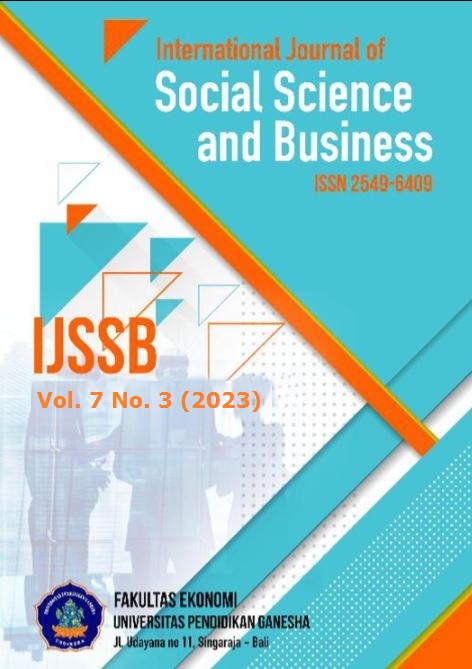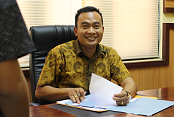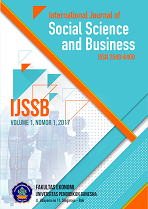The Effect of Travel Experience, Destination Image, and Destination Trust on Revisit Intention at Ubud Monkey Forest
DOI:
https://doi.org/10.23887/ijssb.v7i3.50231Keywords:
travel experience, destination image, destination trust, revisit intentionAbstract
Destination images from traveler ratings may rank differently from person to person. That is why a destination must maintain its image. The aim of this study is to investigate the influence of travel experience, destination image, and destination trust on the intention to revisit Monkey Forest Ubud in Bali, Indonesia. The subject of the research is tourists who have visited Ubud Monkey Forest, Bali. The type of research used is quantitative associative research. Simple random sampling was used a as sampling technique where as many as 400 respondents were selected with the Taro Yamane formula. Data collection using a questionnaire was tested and analyzed by SmartPLS 3 with a measurement model test (outer model), and a structural model test (inner model). This research combines the three constructs to determine their effect on revisit intentions and adds control variables, namely age, and gender. The results of this research indicate that the travel experience has a significant and positive effect on revisit intention, destination image has a significant and positive effect on revisit intention, and destination trust has a significant and positive effect on revisit intention. This research examines the revisit intention of domestic tourists only, further research can develop the research by examining both domestic and international tourists.
References
Abubakar, A. M., Ilkan, M., Al-Tal, R. M., & Eluwole, K. K. (2017). eWOM, revisit intention, destination trust and gender. Journal of Hospitality and Tourism Management, 31, 220–227. https://doi.org/10.1016/j.jhtm.2016.12.005. DOI: https://doi.org/10.1016/j.jhtm.2016.12.005
Agustina, N. K. W. (2018). The Influence Of Destination Images On Revisit Intention In Mount Batur. Journal of Business on Hospitality and Tourism, 4(2), 157–168. https://doi.org/10.22334/jbhost.v4i2.125. DOI: https://doi.org/10.22334/jbhost.v4i2.125
Ahmad, A., Jamaludin, A., Zuraimi, N. S. M., & Valeri, M. (2021). Visit intention and destination image in post-Covid-19 crisis recovery. Current Issues in Tourism, 24(17), 2392–2397. https://doi.org/10.1080/13683500.2020.1842342. DOI: https://doi.org/10.1080/13683500.2020.1842342
Ahn, J., & Kwon, J. (2020). CSR perception and revisit intention: the roles of trust and commitment. Journal of Hospitality and Tourism Insights, 3(5), 607–623. https://doi.org/10.1108/JHTI-02-2020-0022. DOI: https://doi.org/10.1108/JHTI-02-2020-0022
Andayana, M. N., Primus, L. A. K. E., & Oktavianto, A. B. (2023). The Effectiveness of Whatsapp Social Media Use As A Public Communication Means In Tune Village, Tobu District, Tts District. Journal of Tourism Economics and Policy, 2(3), 213–225. https://doi.org/10.38142/jtep.v2i3.484. DOI: https://doi.org/10.38142/jtep.v2i3.484
Anderson, T. W., & Finn, J. D. (2012). The new statistical analysis of data. Springer Science & Business Media.
Ardani, W. (2021). Trust Drivers and Revisit Intention of Foreign Tourists in Bali. Budapest International Research and Critics Institute (BIRCI-Journal): Humanities and Social Sciences, 4(1), 287–297. https://doi.org/10.33258/birci.v4i1.1593. DOI: https://doi.org/10.33258/birci.v4i1.1593
Arini, E., Astuti, B., & Sismanto, A. (2021). Strategi Peningkatan Kunjungan Wisatawan Ke Danau Dendam Tak Sudah Kota Bengkulu. BALANCE: Economic, Business, Management and Accounting Journal, 18(1), 20–28. https://doi.org/10.30651/blc.v18i1.6409. DOI: https://doi.org/10.30651/blc.v18i1.6409
Assaker, G., & Hallak, R. (2013). Moderating Effects of Tourists’ Novelty-Seeking Tendencies on Destination Image, Visitor Satisfaction, and Short- and Long-Term Revisit Intentions. Journal of Travel Research, 52(5), 600–613. https://doi.org/10.1177/0047287513478497. DOI: https://doi.org/10.1177/0047287513478497
Campos, A. C., Mendes, J., do Valle, P. O., & Scott, N. (2017). Co-creating animal-based tourist experiences: Attention, involvement and memorability. Tourism Management, 63, 100–114. https://doi.org/10.1016/j.tourman.2017.06.001. DOI: https://doi.org/10.1016/j.tourman.2017.06.001
Cham, T. H., Cheah, J. H., Ting, H., & Memon, M. A. (2021). Will destination image drive the intention to revisit and recommend? Empirical evidence from golf tourism. International Journal of Sports Marketing and Sponsorship, 23(2), 385–409. https://doi.org/10.1108/IJSMS-02-2021-0040. DOI: https://doi.org/10.1108/IJSMS-02-2021-0040
Chan, W. C., Wan Ibrahim, W. H., Lo, M. C., Mohamad, A. A., Ramayah, T., & Chin, C. H. (2022). Controllable drivers that influence tourists’ satisfaction and revisit intention to Semenggoh Nature Reserve: The moderating impact of destination image. Journal of Ecotourism, 21(2), 147–165. https://doi.org/10.1080/14724049.2021.1925288. DOI: https://doi.org/10.1080/14724049.2021.1925288
Fernaldi, E. H., & Sukresna, I. M. (2018). The influence of tourist evaluative factors on tourist behavioral intention: the mediating role of tourist satisfaction. Diponegoro International Journal of Business, 1(1), 33–39. https://doi.org/10.14710/dijb.1.1.2018.33-39. DOI: https://doi.org/10.14710/dijb.1.1.2018.33-39
Foroudi, P., Palazzo, M., & Sultana, A. (2021). Linking brand attitude to word-of-mouth and revisit intentions in the restaurant sector. British Food Journal, 123(13), 221–240. https://doi.org/10.1108/BFJ-11-2020-1008. DOI: https://doi.org/10.1108/BFJ-11-2020-1008
Foster, B., & Sidhartais, I. (2019). A Perspective From Indonesian Tourists: The Influence Of Destination Image On Revisit Intention. Journal of Applied Business Research (JABR), 35(1), 29–34. https://doi.org/10.19030/jabr.v35i1.10295. DOI: https://doi.org/10.19030/jabr.v35i1.10295
Hassan, S. B., & Soliman, M. (2021). COVID-19 and repeat visitation: Assessing the role of destination social responsibility, destination reputation, holidaymakers’ trust and fear arousal. Journal of Destination Marketing & Management, 19, 100495. https://doi.org/10.1016/j.jdmm.2020.100495. DOI: https://doi.org/10.1016/j.jdmm.2020.100495
Hung, W. L., Lee, Y. J., & Huang, P. H. (2016). Creative experiences, memorability and revisit intention in creative tourism. Current Issues in Tourism, 19(8), 763–770. https://doi.org/10.1080/13683500.2013.877422. DOI: https://doi.org/10.1080/13683500.2013.877422
Jernsand, E. M., Kraff, H., & Mossberg, L. (2015). Tourism Experience Innovation Through Design. Scandinavian Journal of Hospitality and Tourism, 15(1). https://doi.org/10.1080/15022250.2015.1062269. DOI: https://doi.org/10.1080/15022250.2015.1062269
Kang, J. H., Jang, J. C., & Jeong, C. (2018). Understanding museum visitor satisfaction and revisit intentions through mobile guide system: moderating role of age in museum mobile guide adoption. Asia Pacific Journal of Tourism Research, 23(2), 95–108. https://doi.org/10.1080/10941665.2017.1410190. DOI: https://doi.org/10.1080/10941665.2017.1410190
Kim, J. Y., Chung, N., & Ahn, K. M. (2019). The impact of mobile tour information services on destination travel intention. Information Development, 35(1), 107–120. https://doi.org/10.1177/0266666917730437. DOI: https://doi.org/10.1177/0266666917730437
Králiková, A., Peruthová, A., & Ryglová, K. (2020). Impact of destination image on satisfaction and loyalty. Acta Universitatis Agriculturae et Silviculturae Mendelianae Brunensis, 68(1), 199–209. https://doi.org/10.11118/actaun202068010199. DOI: https://doi.org/10.11118/actaun202068010199
Li, Z., & Zhao, Z. (2021). Reliving past experience: memory and rural tourism destination image as predictors of place attachment. Asia Pacific Journal of Tourism Research, 26(12), 1402–1417. https://doi.org/10.1080/10941665.2021.1985545. DOI: https://doi.org/10.1080/10941665.2021.1985545
Mohammed Abubakar, A. (2016). Does eWOM influence destination trust and travel intention: a medical tourism perspective. Economic Research-Ekonomska Istraživanja, 29(1), 598–611. https://doi.org/10.1080/1331677X.2016.1189841. DOI: https://doi.org/10.1080/1331677X.2016.1189841
Nazir, M. U., Yasin, I., Tat, H. H., Khalique, M., & Mehmood, S. A. (2022). The Influence of International Tourists’ Destination Image of Pakistan on Behavioral Intention: The Roles of Travel Experience and Media Exposure. International Journal of Hospitality & Tourism Administration, 23(6), 1266–1290. https://doi.org/10.1080/15256480.2021.1938782. DOI: https://doi.org/10.1080/15256480.2021.1938782
Papadimitriou, D., Apostolopoulou, A., & Kaplanidou, K. (2015). Destination Personality, Affective Image, and Behavioral Intentions in Domestic Urban Tourism. Journal of Travel Research, 54(3), 302–315. https://doi.org/10.1177/0047287513516389. DOI: https://doi.org/10.1177/0047287513516389
Pereira, V., Gupta, J. J., & Hussain, S. (2022). Impact of Travel Motivation on Tourist’s Attitude Toward Destination: Evidence of Mediating Effect of Destination Image. Journal of Hospitality & Tourism Research, 46(5), 946–971. https://doi.org/10.1177/1096348019887528. DOI: https://doi.org/10.1177/1096348019887528
Phan Tan, L. (2023). Customer participation, positive electronic word-of-mouth intention and repurchase intention: The mediation effect of online brand community trust. Journal of Marketing Communications, 1(1), 1–18. https://doi.org/10.1080/13527266.2023.2177709. DOI: https://doi.org/10.1080/13527266.2023.2177709
Pike, S. (2017). Destination positioning and temporality: Tracking relative strengths and weaknesses over time. Journal of Hospitality and Tourism Management, 31, 126–133. https://doi.org/10.1016/j.jhtm.2016.11.005. DOI: https://doi.org/10.1016/j.jhtm.2016.11.005
Poon, W. C., & Koay, K. Y. (2021). Hong Kong protests and tourism: Modelling tourist trust on revisit intention. Journal of Vacation Marketing, 27(2), 217–234. https://doi.org/10.1177/1356766720987881. DOI: https://doi.org/10.1177/1356766720987881
Primananda, P. G. B. N., Yasa, N., Sukaatmadja, I., & Setiawan, P. (2022). Trust as a mediating effect of social media marketing, experience, destination image on revisit intention in the COVID-19 era. International Journal of Data and Network Science, 6(2), 517–526. https://doi.org/10.5267/j.ijdns.2021.12.002. DOI: https://doi.org/10.5267/j.ijdns.2021.12.002
Puh, B. (2014). Destination Image and Tourism Satisfaction: The Case of a Mediterranean Destination. Mediterranean Journal of Social Sciences, 5(13), 538. https://doi.org/10.5901/mjss.2014.v5n13p0538. DOI: https://doi.org/10.5901/mjss.2014.v5n13p0538
Pujiastuti, E. E., Nimran, U., Suharyono, & Kusumawati, A. (2017a). Study On Destination Image, Satisfaction, Trust And Behavioral Intention. Russian Journal of Agricultural and Socio-Economic Sciences, 61(1), 148–159. https://doi.org/10.18551/rjoas.2017-01.15. DOI: https://doi.org/10.18551/rjoas.2017-01.15
Pujiastuti, E. E., Nimran, U., Suharyono, S., & Kusumawati, A. (2017b). The antecedents of behavioral intention regarding rural tourism destination. Asia Pacific Journal of Tourism Research, 22(11), 1169–1181. https://doi.org/10.1080/10941665.2017.1377270. DOI: https://doi.org/10.1080/10941665.2017.1377270
Pujiastuti, E., Utomo, H., & Novamayanti, R. (2020). Millennial tourists and revisit intention. Management Science Letters, 10(12), 2889–2896. https://doi.org/10.5267/j.msl.2020.4.018. DOI: https://doi.org/10.5267/j.msl.2020.4.018
Rachão, S. A. S., de Jesus Breda, Z., de Oliveira Fernandes, C., & Joukes, V. N. P. M. (2021). Drivers of experience co-creation in food-and-wine tourism: An exploratory quantitative analysis. Tourism Management Perspectives, 37, 100783. https://doi.org/10.1016/j.tmp.2020.100783. DOI: https://doi.org/10.1016/j.tmp.2020.100783
Rasoolimanesh, S. M., Seyfi, S., Rastegar, R., & Hall, C. M. (2021). Destination image during the COVID-19 pandemic and future travel behavior: The moderating role of past experience. Journal of Destination Marketing & Management, 21, 100620. https://doi.org/10.1016/j.jdmm.2021.100620. DOI: https://doi.org/10.1016/j.jdmm.2021.100620
Rejikumar, G., Ajitha, A. A., Jose, A., & Mathew, S. (2021). Strategic positioning of tourist destinations- analyzing the role of perceived meaningfulness. Journal of Hospitality and Tourism Management, 49, 140–151. https://doi.org/10.1016/j.jhtm.2021.08.025. DOI: https://doi.org/10.1016/j.jhtm.2021.08.025
Sadat, A., Lawelai, H., Hastuti, H., Nurfaiza, N., & Restiani, S. A. (2023). Digital Tourism Training for Tourism Awareness Groups in Galanti Village, Buton Regency. Society: Jurnal Pengabdian Masyarakat, 2(1), 25–30. https://doi.org/10.55824/jpm.v2i1.234. DOI: https://doi.org/10.55824/jpm.v2i1.234
Satria, E. (2018). Analisa Strategi Promosi Dinas Pariwisata dan Kebudayaan dalam Meningkatkan Jumlah Kunjungan Wisatawan di Kabupaten Kerinci. Eksis: Jurnal Ilmiah Ekonomi Dan Bisnis, 9(1), 53–63. https://doi.org/10.33087/eksis.v9i1.133. DOI: https://doi.org/10.33087/eksis.v9i1.133
Sekaran, U., & Bougie, R. (2016). Research methods for business: A skill building approach. john wiley & sons.
Shen, Y. S., Jo, W., & Joppe, M. (2022). Role of country image, subjective knowledge, and destination trust on travel attitude and intention during a pandemic. Journal of Hospitality and Tourism Management, 52, 275–284. https://doi.org/10.1016/j.jhtm.2022.07.003. DOI: https://doi.org/10.1016/j.jhtm.2022.07.003
Siregar, M. R., Siregar, M. I., Saputra, J., Muzammil, A., & Muhammad, Z. (2021). The mediating role of service quality, tourists’ satisfaction and destination trust in the relationship between destination image and tourist revisiting intention. Journal of Environmental Management & Tourism, 12(6), 1603–1616. https://www.ceeol.com/search/article-detail?id=1019628. DOI: https://doi.org/10.14505//jemt.12.6(54).16
Song, H. M., Kim, K. S., & Yim, B. H. (2017). The mediating effect of place attachment on the relationship between golf tourism destination image and revisit intention. Asia Pacific Journal of Tourism Research, 22(11), 1182–1193. https://doi.org/10.1080/10941665.2017.1377740. DOI: https://doi.org/10.1080/10941665.2017.1377740
Soonsan, N., & Somkai, U. (2022). Linking Perceived Destination Image and Revisiting Intention: A Cross-cultural Study of Chinese and Australian Tourists. Journal of China Tourism Research, 18(4), 689–709. https://doi.org/10.1080/19388160.2021.1964669. DOI: https://doi.org/10.1080/19388160.2021.1964669
Sørensen, F., & Jensen, J. F. (2015). Value creation and knowledge development in tourism experience encounters. Tourism Management, 46, 336–346. https://doi.org/10.1016/j.tourman.2014.07.009. DOI: https://doi.org/10.1016/j.tourman.2014.07.009
Souiden, N., Ladhari, R., & Chiadmi, N. E. (2017). Destination personality and destination image. Journal of Hospitality and Tourism Management, 32, 54–70. https://doi.org/10.1016/j.jhtm.2017.04.003. DOI: https://doi.org/10.1016/j.jhtm.2017.04.003
Tan, W. K. (2017). Repeat visitation: A study from the perspective of leisure constraint, tourist experience, destination images, and experiential familiarity. Journal of Destination Marketing & Management, 6(3), 233–242. https://doi.org/10.1016/j.jdmm.2016.04.003. DOI: https://doi.org/10.1016/j.jdmm.2016.04.003
Thipsingh, S., Srisathan, W. A., Wongsaichia, S., Ketkaew, C., Naruetharadhol, P., & Hengboriboon, L. (2022). Social and sustainable determinants of the tourist satisfaction and temporal revisit intention: A case of Yogyakarta, Indonesia. Cogent Social Sciences, 8(1), 2068269. https://doi.org/10.1080/23311886.2022.2068269. DOI: https://doi.org/10.1080/23311886.2022.2068269
Untara, I. M. G. S., & Supada, W. (2020). Eksistensi Pura Tanah Lot Dalam Perkembangan Pariwisata Budaya Di Kabupaten Tabanan. Cultoure: Jurnal Ilmiah Pariwisata Budaya Hindu, 1(2), 186–197. https://doi.org/10.55115/cultoure.v1i2.833.
Wiwin, I. W. (2018). Community Based Tourism Dalam Pengembangan Pariwisata Bali. Pariwisata Budaya: Jurnal Ilmiah Agama Dan Budaya, 3(1), 69–75. https://doi.org/10.25078/pba.v3i1.424. DOI: https://doi.org/10.25078/pba.v3i2.602
Yang, S., Isa, S. M., Ramayah, T., Blanes, R., & Kiumarsi, S. (2020). The effects of destination brand personality on Chinese tourists’ revisit intention to Glasgow: an examination across gender. Journal of International Consumer Marketing, 32(5), 435–452. https://doi.org/10.1080/08961530.2020.1717400. DOI: https://doi.org/10.1080/08961530.2020.1717400
Yang, S., Isa, S. M., Ramayah, T., Wen, J., & Goh, E. (2022). Developing an extended model of self-congruity to predict Chinese tourists’ revisit intentions to New Zealand: the moderating role of gender. Asia Pacific Journal of Marketing and Logistics, 34(7), 1459–1481. https://doi.org/10.1108/APJML-05-2021-0346. DOI: https://doi.org/10.1108/APJML-05-2021-0346
Yin, C. Y., Poon, P., & Su, J. L. (2017). Yesterday once more? Autobiographical memory evocation effects on tourists’ post-travel purchase intentions toward destination products. Tourism Management, 61, 263–274. https://doi.org/10.1016/j.tourman.2017.02.014. DOI: https://doi.org/10.1016/j.tourman.2017.02.014
Yudhistira, P. G. A., Andriyani, N. K. R., & Yasa, I. G. A. S. (2022). Domestic Tourists’ Revisit Intention: The Role of Novelty and Destination Image at Hidden Canyon Beji Guwang. International Journal of Social Science and Business, 6(2). https://doi.org/10.23887/ijssb.v6i2.46014. DOI: https://doi.org/10.23887/ijssb.v6i2.46014
Downloads
Published
How to Cite
Issue
Section
License
Copyright (c) 2023 Natasha Valentine Trius, Ni Ketut Wiwiek Agustina, Putu Gde Arie Yudhistira

This work is licensed under a Creative Commons Attribution-ShareAlike 4.0 International License.











